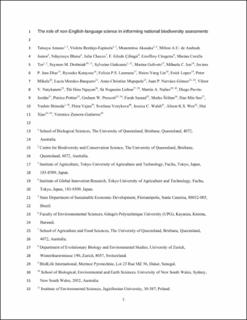The role of non-English-language science in informing national biodiversity assessments
Amano, Tatsuya; Berdejo, Violeta; Akasaka, Munemitsu; Andrade Junior, Milton; Blaise, N; Checco, Julia; Çilingir, F; Citegetse, G; Tor, MC; Drobniak, Szymon M.; Giakoumi, Sylvaine; Golivets, M; Ion, M; Jara-Díaz, J; Katayose, R; Lasmana, Felicia; Lin, HY; Lopez, Erik; Mikula, P; Morales-Barquero, Lucia; Mupepele, AC; Narváez-Gómez, J; Nguyen, T; Nogueira Lisboa, Sa; Nuñez, Martin; Pavòn-Jordàn, Diego; Pottier, P; Prescott, Graham W.; Samad, F; Šćiban, Marko; Seo, HM; Shinoda, Y; Vajna, F; Vozykova, S; Walsh, Jessica C.; Wee, AKS; Xiao, Hui; Zamora-Gutierrez, Veronica
Peer reviewed, Journal article
Accepted version

View/
Date
2023Metadata
Show full item recordCollections
- Publikasjoner fra CRIStin - NINA [2364]
- Scientific publications [1392]
Original version
10.1038/s41893-023-01087-8Abstract
Consulting the best available evidence is key to successful conservation decision-making. While much scientific evidence on conservation continues to be published in non-English languages, a poor understanding of how non-English-language science contributes to conservation decision-making is causing global assessments and studies to practically ignore non-English-language literature. By investigating the use of scientific literature in biodiversity assessment reports across 37 countries/territories, we have uncovered the established role of non-English-language literature as a major source of information locally. On average, non-English-language literature constituted 65% of the references cited, and these were recognized as relevant knowledge sources by 75% of report authors. This means that by ignoring non-English-language science, international assessments may overlook important information on local and/or regional biodiversity. Furthermore, a quarter of the authors acknowledged the struggles of understanding English-language literature. This points to the need to aid the use of English-language literature in domestic decision-making, for example, by providing non-English-language abstracts or improving and/or implementing machine translation. (This abstract is also avaialble in 21 other languages in Supplementary Data 4).
